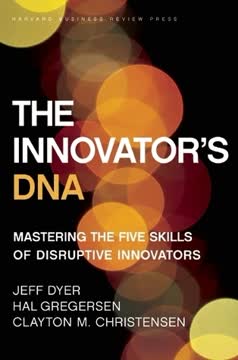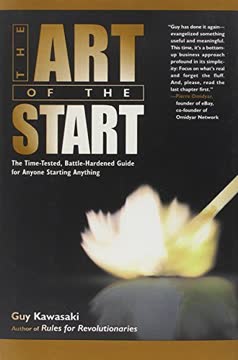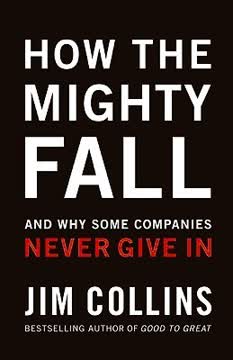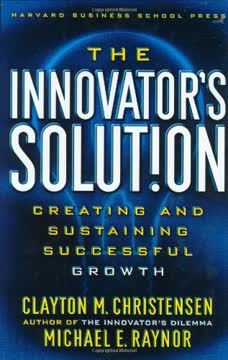Key Takeaways
1. Disruptive innovation is the key to creating new growth businesses
Disruption does not guarantee success, but it sure helps: The Innovator's Dilemma showed that following a strategy of disruption increased the odds of creating a successful growth business from 6 percent to 37 percent.
Disruptive innovation offers a significantly higher probability of success in building new-growth businesses compared to sustaining innovations. Disruptive innovations introduce simpler, more convenient, and less expensive products that appeal to new or less-demanding customers. They typically take root in two types of markets:
- Low-end disruptions: Target overserved customers with a lower-cost business model
- New-market disruptions: Compete against nonconsumption, enabling new populations to begin using a product
Successful disruptors follow a consistent pattern:
- Start with a technology that is "good enough" for unserved or underserved customers
- Improve the product over time along a trajectory of innovation
- Eventually displace established competitors as performance improves
2. Identify jobs customers are trying to get done, not just product attributes
Customers—people and companies—have "jobs" that arise regularly and need to get done. When customers become aware of a job that they need to get done in their lives, they look around for a product or service that they can "hire" to get the job done.
Jobs-to-be-done framework: Instead of segmenting markets based on customer attributes or product characteristics, focus on the underlying job that customers are trying to accomplish. This approach provides several advantages:
- Reveals true competition across product categories
- Uncovers opportunities for innovation and growth
- Guides product development to better meet customer needs
Example: Milkshake study
- Morning commuters "hired" milkshakes to:
- Make commute more interesting
- Stave off hunger until lunch
- Be consumed easily while driving
- Competing products: Bagels, bananas, breakfast bars
By understanding the job, the company could improve the milkshake to better serve customers' needs, rather than simply tweaking product attributes.
3. Target nonconsumption to find disruptive footholds
Competing against nonconsumption often offers the biggest source of growth in a world of one-size-fits-all products that do no jobs satisfactorily.
Nonconsumption opportunities arise when people are trying to get a job done but are unable to do so because existing solutions are:
- Too expensive
- Too complicated
- Inaccessible
Targeting nonconsumption offers several advantages:
- Less direct competition from established players
- Lower performance requirements to satisfy customers
- Potential for rapid adoption and market growth
Examples of successful disruptions targeting nonconsumption:
- Personal computers (vs. mainframes)
- Cellular phones (vs. landlines)
- Discount retailers (vs. department stores)
To identify nonconsumption opportunities:
- Look for situations where people "hire" workarounds or suboptimal solutions
- Identify barriers preventing broader adoption of existing products
- Develop simpler, more accessible solutions to address unmet needs
4. Integrate when performance is not good enough, modularize when it overshoots
The problem is that in an attempt to build convincing business cases for new products, managers are compelled to quantify the opportunities they perceive, and the data available to do this are typically cast in terms of product attributes or the demographic and psychographic profiles of a given population of potential consumers.
Performance trajectory: Understanding where a product falls on its performance trajectory is crucial for determining the appropriate business strategy and organizational structure.
-
Not good enough: When product functionality and reliability don't meet customer needs
- Interdependent, proprietary architectures are advantageous
- Vertical integration is necessary to optimize performance
- Examples: Early stages of new industries or technologies
-
More than good enough: When products overshoot customer needs
- Modular architectures become prevalent
- Industry structure tends to dis-integrate
- Compete on speed, convenience, and customization
- Examples: Mature industries with standardized products
Implications for managers:
- Assess where your products are on the performance trajectory
- Align your business model and organizational structure accordingly
- Be prepared to shift strategies as the basis of competition changes
5. Commoditization and de-commoditization occur reciprocally in value chains
Whenever commoditization is at work somewhere in a value chain, a reciprocal process of de-commoditization is at work somewhere else in the value chain.
Value chain dynamics: Understanding the interplay between commoditization and de-commoditization is crucial for identifying future profit opportunities.
Commoditization process:
- Product overshoots customer needs
- Modular architectures emerge
- Industry structure dis-integrates
- Profits erode in the commoditized segment
De-commoditization process:
- Performance-defining subsystems become critical
- Proprietary, interdependent architectures re-emerge
- Opportunities for differentiation and higher profits arise
Key insights:
- Profit potential shifts across the value chain over time
- Focus on areas where customer needs are not yet satisfied
- Be prepared to move up or down the value chain as needed
Example: Personal computer industry
- Initial profits in computer assembly (e.g., IBM)
- Shifted to operating systems and microprocessors (Microsoft, Intel)
- Now moving to internet services and mobile devices
6. Match organizational capabilities to the task at hand
Our purpose in this chapter is to help managers understand how these processes of commoditization and de-commoditization work, so that they can detect when and where they are beginning to happen.
Organizational capabilities are determined by three factors:
- Resources: Tangible assets (people, equipment, technology, cash)
- Processes: Patterns of interaction, coordination, and decision-making
- Values: Criteria for prioritization and resource allocation
Matching capabilities to innovation types:
- Sustaining innovations: Leverage existing capabilities within mainstream organization
- Disruptive innovations: Create new capabilities through autonomous organizations
Assessing organizational fit:
- Do we have the right resources?
- Are our processes appropriate for the task?
- Will our values prioritize this initiative?
Creating new capabilities:
- Develop new processes through heavyweight teams
- Create new values by establishing autonomous business units
- Acquire capabilities selectively, preserving key processes and values
7. Create new capabilities through careful resource allocation and autonomous units
It's relatively straightforward to find the ideal customers for a low-end disruption. They are current users of a mainstream product who seem disinterested in offers to sell them improved-performance products.
Building new capabilities is essential for successful disruptive innovation. Key strategies include:
-
Resource allocation:
- Frame disruptive opportunities as threats to secure initial funding
- Shift to opportunity framing for implementation and growth
- Create a separate process for evaluating disruptive ideas
-
Autonomous units:
- Establish independent organizations for disruptive initiatives
- Allow new processes and values to develop
- Protect from mainstream business pressures
-
Management development:
- Identify high-potential managers based on learning ability
- Provide opportunities to gain relevant experience
- Balance short-term results with long-term capability building
-
Acquisition strategy:
- Acquire for resources, processes, or values
- Integrate acquisitions when resources are primary
- Preserve autonomy when processes and values are critical
By carefully managing these elements, companies can create the capabilities needed to successfully pursue disruptive growth opportunities while maintaining their core business.
Last updated:
FAQ
What's The Innovator's Solution about?
- Focus on Disruption: The book explores how companies can achieve and maintain successful growth by becoming disruptors in their industries, building on concepts from The Innovator's Dilemma.
- Nine Key Decisions: It outlines nine critical business decisions essential for growth, such as identifying the right customers and managing strategy development.
- Understanding Innovation: The authors argue that innovation often fails because organizations strip the disruptive potential from new ideas before they can be realized.
Why should I read The Innovator's Solution?
- Practical Framework: The book provides a practical framework for creating disruptive innovations, valuable for managers and entrepreneurs.
- Real-World Examples: It includes numerous case studies from various industries, illustrating how principles can be applied in real-world scenarios.
- Improved Success Rates: By following the strategies outlined, companies can significantly increase their chances of successfully launching new products and services.
What are the key takeaways of The Innovator's Solution?
- Disruptive vs. Sustaining Innovations: Understanding the difference between sustaining innovations and disruptive innovations is crucial for growth.
- Customer-Centric Approach: Companies should focus on the jobs customers are trying to get done, rather than just product attributes.
- Organizational Structure Matters: The book emphasizes the importance of having the right organizational structure to support disruptive innovations.
What is the definition of disruptive innovation in The Innovator's Solution?
- Disruptive Innovation Defined: It refers to a process where a smaller company with fewer resources successfully challenges established businesses.
- Market Entry: These innovations target overlooked market segments, starting with simpler, cheaper products for less demanding customers.
- Improvement Trajectory: Over time, these products improve and begin to attract more demanding customers, ultimately displacing established competitors.
How can companies identify disruptive opportunities according to The Innovator's Solution?
- Three Litmus Tests: The authors suggest identifying new-market opportunities, assessing low-end disruption potential, and ensuring the innovation disrupts significant incumbents.
- Focus on Nonconsumption: Companies should look for large populations of potential customers who currently do not use the product or service.
- Evaluate Business Models: Creating a business model that can profitably serve new or low-end markets is essential for sustaining innovation financially.
What is the "jobs to be done" concept in The Innovator's Solution?
- Customer-Centric Approach: This framework focuses on understanding what customers are trying to achieve rather than just their demographics or product attributes.
- Market Segmentation: By identifying specific jobs customers need to accomplish, companies can segment their markets more effectively.
- Innovation Opportunities: This concept helps businesses identify new opportunities for innovation by focusing on unmet customer needs.
How does The Innovator's Solution suggest companies avoid commoditization?
- Understanding Commoditization: Commoditization occurs when products become indistinguishable, leading to price competition.
- Focus on Unique Value: Companies should create unique value propositions that differentiate their products from competitors.
- Continuous Innovation: Ongoing innovation and improvement in product features and customer experience are essential to maintain competitive advantages.
What is the RPV framework in The Innovator's Solution?
- Definition of RPV: The RPV framework stands for Resources, Processes, and Values, which define an organization’s capabilities.
- Assessment Tool: It serves as a tool for assessing whether an organization is equipped to pursue new growth opportunities.
- Guiding Resource Allocation: Understanding RPV helps companies make informed decisions about resource allocation and process structuring.
How does The Innovator's Solution suggest structuring teams for new-growth businesses?
- Assess Capabilities: Evaluate resources, processes, and values of potential team members to align with new-growth goals.
- Autonomous Organizations: Creating autonomous teams can foster innovation and agility, allowing them to operate independently.
- Diverse Experiences: Teams should include individuals with varied backgrounds to bring different perspectives and skills.
What role do senior executives play in managing disruptive growth according to The Innovator's Solution?
- Vision and Direction: Senior executives set the vision and strategic direction for new growth initiatives.
- Resource Support: They must allocate resources effectively to support innovation efforts, including funding and talent acquisition.
- Cultural Influence: Executives foster a culture that encourages experimentation and embraces potential failure as part of the innovation process.
What are the challenges of managing disruptive innovation in The Innovator's Solution?
- Resistance to Change: Established processes and values can create resistance to new ideas, hindering disruptive innovations.
- Resource Allocation Conflicts: Balancing resources between sustaining and disruptive innovations can lead to internal conflicts.
- Market Uncertainty: Disruptive innovations often target uncertain markets, making it challenging to predict their success.
What are the best quotes from The Innovator's Solution and what do they mean?
- "Disruption works because it is much easier to beat competitors when they are motivated to flee rather than fight.": Understanding competitors' motivations can provide strategic advantages in innovation.
- "The best way for upstarts to attack established competitors is to disrupt them.": Targeting markets that incumbents ignore creates opportunities for new entrants.
- "Customers hire products to get jobs done.": Companies should focus on customers' actual needs and circumstances to drive innovation.
Review Summary
The Innovator's Solution is highly regarded for its insightful analysis of disruptive innovation in business. Readers praise its practical advice, case studies, and theoretical models for fostering innovation. Many find it thought-provoking and applicable beyond just business contexts. Some criticize the dense writing style and outdated examples. Overall, it's considered a valuable resource for understanding market dynamics, product development, and organizational strategy, though it may require effort to digest fully.
Similar Books










Download PDF
Download EPUB
.epub digital book format is ideal for reading ebooks on phones, tablets, and e-readers.












